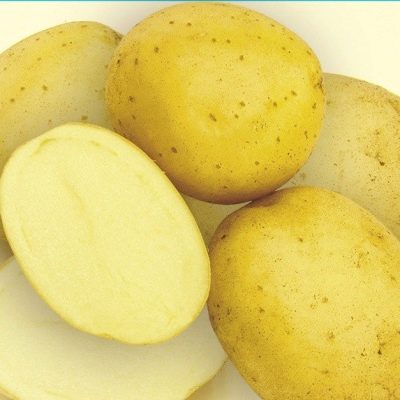
- Authors: Sklyarova N.P., Simakov E.A., Grigoriev G.V., Loginov S.I., Shabanov A.E., Mityushkin A.V., Uskov A.I., Varitseva G.P. (FGBNU "VNIIKH named after A.G. Lorkh")
- Appeared when crossing: Hybrid 2953-34 x Shurminsky 2
- Year of approval: 2005
- Appointment: table, suitable for the production of dry potato products
- Tuber weight, g: 78-105
- Peel color: yellow
- Color of the pulp: cream
- Starch content,%: 10,0-12,1%
- Tuber shape: oval
- Peel structure: smooth
Krepysh is a potato variety bred by specialists of the FGBNU VNIIKH im. A. G. Lorkha ". The parents of the strong man can be considered the varieties Hybrid 2953-34 and Shurminsky 2, and the variety was approved for use in 2005. Over the years, all the pros and cons of the Krepysh variety have been well studied. Let's get to know him better.
Description of the variety
The presented variety is approved for cultivation in the northern, North-West, Central, Central Black Earth and Far Eastern regions. In addition, it is common in other countries, for example, in Moldova and Ukraine.
It is a disease resistant variety with good taste and low starch content, as well as excellent marketability.
Characteristics of the appearance of the bush and root crops
The presented variety is characterized by the following external features:
erect bush, medium or tall in size, intermediate type;
leaves are green or dark green, with wavy edges, medium in size;
the flowers are large, the color is red-violet;
inflorescence is medium or large;
root crops are oval, yellow, smooth, the depth of the eyes is average, weight 78-105 g, 7-8 tubers are formed under one bush.
Purpose and taste of tubers
Root vegetables are characterized by a very pleasant taste, they boil well, and are also suitable for the production of dry potato products. After cooking, the vegetable does not darken, but in its raw form it may darken slightly, the creamy pulp contains 10.0-12.1% starch. In addition, this potato has a high keeping quality - up to 97%.
Maturation
This variety belongs to the early ripening varieties. Harvesting is done 60-70 days after the first sprouting.
Yield
This is a high-yielding variety, which on average gives 127-242 c / ha, and the maximum indicator is 276 c / ha.
Growing and care
This variety has medium drought resistance. It is customary to plant it in May. When planting, 60 cm should be left between two future bushes, and 35 cm between rows. Tubers should be buried 8-10 cm. The first loosening of the soil is carried out within a couple of weeks after planting. Before this procedure, gardeners are advised to apply soluble fertilizers, chicken droppings or manure. The presented variety is responsive to the application of optimal doses of mineral fertilizers. It does not require regular watering, but if the ridges are moistened during the period of bud formation and flowering, this will be an excellent incentive to produce a high-quality and bountiful harvest.

Planting potatoes is one of the main spring activities traditional for Russian gardeners. There are many ways to plant this vegetable, allowing you to get a good harvest in different conditions and climates. Before planting, you need to carefully prepare the planting material, correctly determine the timing, competently prepare the soil.


Soil requirements
When choosing a site, give preference to ridges located in a sunny place. Such a site is quickly warmed up after winter and protected from stagnant water. Choose land where perennial or annual grasses, winter crops and cereals, flax were previously cultivated. In sandy soils, it is allowed to plant this culture after lupine.

Disease and pest resistance
This variety has a very high immunity against such common "potato" ailments as cancer, alternaria, various viruses, scab, but it can be affected by late blight of leaves and tubers. This disease can be distinguished by dark spots. To prevent disease, fungicide treatments should be used already at the beginning of tuber formation. Be sure to destroy any green mass that remains after harvesting in the fall.
And also the presented variety can become a victim of the Colorado potato beetle. The most effective way to combat this pest is the mechanical collection of individuals and their destruction. Some gardeners make poison from the insects themselves. They immerse them in a jar, fill it with water and leave it to infuse. The prepared composition is again diluted with water and sprayed with tops. Among the purchased funds, gardeners praise Sonnet, Prestige, and Confidor.

Potatoes are a popular vegetable crop that many gardeners planted on their site. But it is unlikely that it will be possible to grow a bountiful harvest of tasty and large tubers if the beds are not properly protected from the most common diseases and pests. Often, the development of diseases of various etiologies of potatoes goes unnoticed, so it is important to identify the problem in time and eliminate it.
















































































